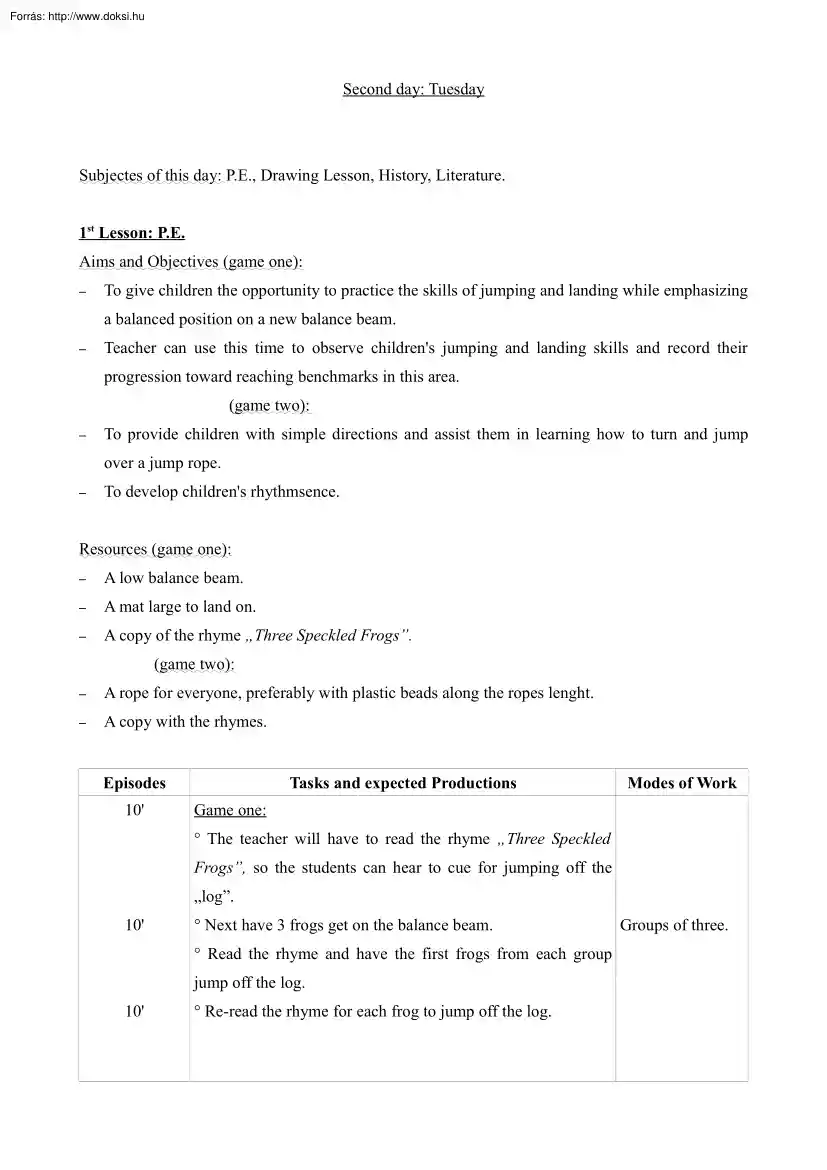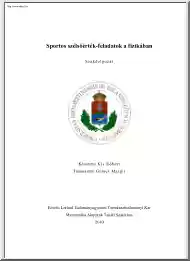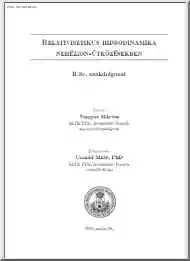Please log in to read this in our online viewer!

Please log in to read this in our online viewer!
No comments yet. You can be the first!
What did others read after this?
Content extract
Second day: Tuesday Subjectes of this day: P.E, Drawing Lesson, History, Literature 1st Lesson: P.E Aims and Objectives (game one): – To give children the opportunity to practice the skills of jumping and landing while emphasizing a balanced position on a new balance beam. – Teacher can use this time to observe children's jumping and landing skills and record their progression toward reaching benchmarks in this area. (game two): – To provide children with simple directions and assist them in learning how to turn and jump over a jump rope. – To develop children's rhythmsence. Resources (game one): – A low balance beam. – A mat large to land on. – A copy of the rhyme „Three Speckled Frogs”. (game two): – A rope for everyone, preferably with plastic beads along the ropes lenght. – A copy with the rhymes. Episodes 10' Tasks and expected Productions Modes of Work Game one: ° The teacher will have to read the rhyme „Three Speckled
Frogs”, so the students can hear to cue for jumping off the „log”. 10' ° Next have 3 frogs get on the balance beam. ° Read the rhyme and have the first frogs from each group jump off the log. 10' ° Re-read the rhyme for each frog to jump off the log. Groups of three. Game two: 30' ° Hold the rope by the handles, one in each hand. ° Hold the rope out on fron of your body. ° Step over the rope. Whole class. ° Bend your elbows up close to your ears. ° Move the arms forward and swing the rope over your head. ° Let the rope hit the floor. ° Jump over the rope, taking off the landing on two feet. Note: teacher says a jump rope rhyme, and when another rhyme comes, the children change the directions. 2nd Lesson: Drawing Aims and Objectives: – To develop basic knowledge and gain experience with weaving. – Students will produce a simple weaving projekt and will be able to discuss the basic vocabulary of weaving. Resources: – Two 9” x 12”
sheets of paper in different colors per student. – Glues, scissors, trimmers, shears. – Rulers and measement tools. Episodes 10' Tasks and expected Productions The teacher may prepare a sample(s) ahead of time for Modes of Work Whole class talk showing to the class. Begin with a brief discussion of weaving with the teacher and what it is (the interlacing of threads to form a continuous piece of fabric). Write vocabulary list on board and discuss Show example(s). Weaving The process of forming cloth or fabric on a 30' loom by interlacing yarn or thread (or, as in this case, paper). Loom A frame for weaving yarn or thread into cloth or fabric. Warp Threads running lengthwise on the loom. The Individual work. warp is placed on the loom prior to beginning the weaving process. Weft Threads that are weaved across the warp threads to form the web. Web The cloth or fabric produced by weaving. Distribute materials and tools. Students fold one sheet of paper
horizontally. Draw a line about one inch from the open end of the Student help each folded paper. This is the limit of cutting other From the fold, make irregular cuts up to the line. Cuts any group work. need not be straight. (The irregular cuts make a more interesting finished product.) Unfold and lay it flat 20' This will serve as the "warp" and the "loom." Measure and cut from the second sheet of paper, oneinch wide by nine-inch strips. These will serve as the "weft." Tip: Teacher may precut the one-inch weft strips. Begin by weaving one "weft thread" over one "warp thread" then under the next warp and over the next, etc. Continue this process alternating over and under with each weft thread. If the previous weft thread went under the warp thread, the following row will begin by going over the warp. – without 3rd Lesson: History Aims and Objectives: – To find Greece and Italy on the world map. – To make
groups to write and perform a newscast about Ancient Greece and Rome. Resources: – Matchup: Greece and Ancient Rome. Episodes Tasks and expected Objectives 15' ° The teacher breaks students into groups and have them write Modes of Work and preform a newscast. ° They have to write it as if it were in the times of the Romans Group work. and Ancient Greece. They have to have it about: entertainment, parlor games, theatre, cartraces, gladiatorcombat, spas. ° The student may use the Usborne Picture Dictionary. 20' ° It is possible to act as a gladiator, actor, etc. Individual work. ° Without acting anything, they can just make a speech about what they read. 25' Group work. ° The children find the words in the matchups. 4th Lesson: Literature Aims and Objectives: – To find out the meaning of the strange words. – To develop communication skill, comprehension. – To develop listening behaviour. Resources: – Amy Peters: The Everything Fairy
Tales Book – The Flea (page 25-27.) During one hour the children listen to the fairy tale, from where they have to collect the unknown words, which can be explained later. Either with a dictionary or just from another student The best is, if the pupils can tell to the audience the story with their own vocabulary
Frogs”, so the students can hear to cue for jumping off the „log”. 10' ° Next have 3 frogs get on the balance beam. ° Read the rhyme and have the first frogs from each group jump off the log. 10' ° Re-read the rhyme for each frog to jump off the log. Groups of three. Game two: 30' ° Hold the rope by the handles, one in each hand. ° Hold the rope out on fron of your body. ° Step over the rope. Whole class. ° Bend your elbows up close to your ears. ° Move the arms forward and swing the rope over your head. ° Let the rope hit the floor. ° Jump over the rope, taking off the landing on two feet. Note: teacher says a jump rope rhyme, and when another rhyme comes, the children change the directions. 2nd Lesson: Drawing Aims and Objectives: – To develop basic knowledge and gain experience with weaving. – Students will produce a simple weaving projekt and will be able to discuss the basic vocabulary of weaving. Resources: – Two 9” x 12”
sheets of paper in different colors per student. – Glues, scissors, trimmers, shears. – Rulers and measement tools. Episodes 10' Tasks and expected Productions The teacher may prepare a sample(s) ahead of time for Modes of Work Whole class talk showing to the class. Begin with a brief discussion of weaving with the teacher and what it is (the interlacing of threads to form a continuous piece of fabric). Write vocabulary list on board and discuss Show example(s). Weaving The process of forming cloth or fabric on a 30' loom by interlacing yarn or thread (or, as in this case, paper). Loom A frame for weaving yarn or thread into cloth or fabric. Warp Threads running lengthwise on the loom. The Individual work. warp is placed on the loom prior to beginning the weaving process. Weft Threads that are weaved across the warp threads to form the web. Web The cloth or fabric produced by weaving. Distribute materials and tools. Students fold one sheet of paper
horizontally. Draw a line about one inch from the open end of the Student help each folded paper. This is the limit of cutting other From the fold, make irregular cuts up to the line. Cuts any group work. need not be straight. (The irregular cuts make a more interesting finished product.) Unfold and lay it flat 20' This will serve as the "warp" and the "loom." Measure and cut from the second sheet of paper, oneinch wide by nine-inch strips. These will serve as the "weft." Tip: Teacher may precut the one-inch weft strips. Begin by weaving one "weft thread" over one "warp thread" then under the next warp and over the next, etc. Continue this process alternating over and under with each weft thread. If the previous weft thread went under the warp thread, the following row will begin by going over the warp. – without 3rd Lesson: History Aims and Objectives: – To find Greece and Italy on the world map. – To make
groups to write and perform a newscast about Ancient Greece and Rome. Resources: – Matchup: Greece and Ancient Rome. Episodes Tasks and expected Objectives 15' ° The teacher breaks students into groups and have them write Modes of Work and preform a newscast. ° They have to write it as if it were in the times of the Romans Group work. and Ancient Greece. They have to have it about: entertainment, parlor games, theatre, cartraces, gladiatorcombat, spas. ° The student may use the Usborne Picture Dictionary. 20' ° It is possible to act as a gladiator, actor, etc. Individual work. ° Without acting anything, they can just make a speech about what they read. 25' Group work. ° The children find the words in the matchups. 4th Lesson: Literature Aims and Objectives: – To find out the meaning of the strange words. – To develop communication skill, comprehension. – To develop listening behaviour. Resources: – Amy Peters: The Everything Fairy
Tales Book – The Flea (page 25-27.) During one hour the children listen to the fairy tale, from where they have to collect the unknown words, which can be explained later. Either with a dictionary or just from another student The best is, if the pupils can tell to the audience the story with their own vocabulary




 When reading, most of us just let a story wash over us, getting lost in the world of the book rather than paying attention to the individual elements of the plot or writing. However, in English class, our teachers ask us to look at the mechanics of the writing.
When reading, most of us just let a story wash over us, getting lost in the world of the book rather than paying attention to the individual elements of the plot or writing. However, in English class, our teachers ask us to look at the mechanics of the writing.